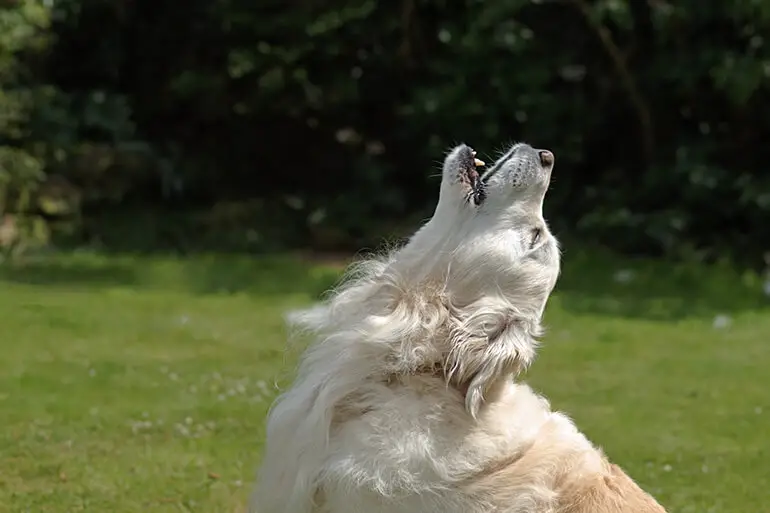Have you ever wondered why a dog howls at night, at a siren, at the moon, suddenly, in a sleep, to music, when you sing, and when you leave? Let’s try to figure it out.
Reasons Why a Dog Howls (Sounds That Make Dogs Howl)

Feels Lonely
The dog got bored and thus decided to attract the attention of the owner. This usually happens when everyone in the house is busy with their own business and does not pay attention to it.
How it manifests itself: The dog howls at home for no apparent reason.
What to do: Take some time for your dog – talk to him, play, pet, arrange an extraordinary short walk.
Bored
The dog howls when stressed. Most often this happens due to a long separation from the owner. The dog begins to feel very sad.
How it manifests itself: the dog howls during the day because no one is at home for a long time.
What to do: Try to shorten the time of your absence, especially when it comes to the puppy – he should gradually get used to being at home alone.
Fears
The reason for this behavior of the dog can be fright or fear, caused, for example, by very loud sounds from the street or inside the apartment.
How it manifests itself: the animal begins to howl when he hears the howl of a siren or is in a room where music is playing very loudly.
What to do: Avoid too loud “callsigns” in the house – do not frighten or alert the dog once again. Be sure to train your dog so that he can calmly perceive various noises and loud sound effects.
Hungry or Thirsty
A dog may start howling when it feels intense hunger or thirst and is unable to feed it.
How it manifests itself: the animal approaches the place where its food lies, and, sitting nearby, begins to howl. When the dog is thirsty, it sticks out its tongue.
What to do: Make sure your pet has access to clean water at all times (especially when you are away). Feed the dog at the same time, give a sufficient amount of food according to its breed, weight, and other characteristics.
Wants to Go to the Toilet
The dog howls when it really needs to empty, but it cannot do it, for example, in an apartment.
How it manifests itself: the dog most often runs up to the front door, sits down, and begins to howl. This means that she asks to go outside to relieve herself.
What to do: take your dog outside regularly, train him to walk.
Feels Attracted
The dog in the yard shows interest in other individuals, and not having received satisfaction, howls.
How it manifests itself: the male howls if he is not taken with the female, and vice versa.
What to do: Pets are recommended to be neutered or spayed, otherwise, mating is necessary.
Communicates
For a dog, howl is a means of communication with congeners, so it may be caused by a simple desire to communicate with another animal. For example, a dog howls at night in the yard because he hears the howl of another dog on the street.
How it manifests itself: when a dog hears the howl of another dog, it “picks up” him.
What to do: educate the dog, train it so that it does not react to extraneous noises and sounds, including the howling of a dog.
Sick
Sometimes the howl of a dog can become a reason for the owner’s anxiety: if the pet is bad, he expresses his pain in this way.
How it manifests itself: the animal howls, looks unhappy and downcast, cannot find a place for itself, takes strange postures.
What to do: monitor your pet’s health, visit your veterinarian regularly and seek help if in doubt about the dog’s condition.
Insufficiently Trained
At home, a puppy usually howls, not yet accustomed to having fun on its own in the absence of people, or an insufficiently trained dog.
How it manifests itself: The dog starts howling as soon as the owner leaves the house.
What to do: teach the dog from childhood to be alone, calm perception of temporary separation from the owner, and the ability to entertain himself with toys.
Is Experiencing Discomfort
A dog is a pet that loves large areas and needs ample room to maneuver. Sometimes the dog whines and howls, because this space is not enough for it.
How it manifests itself: The dog howls when tethered or sitting in a small room.
What to do: The dog breeder must have sufficient living space for the animal to live comfortably. In general, walk your pet more, providing it with ample space for running, playing, and training.
Why Does My Puppy Howl?
The main reason why a puppy howls: he is not yet used to being without an owner and does not know how to occupy himself (for example, with toys, as adult dogs do). Therefore, it is very important to socialize your dog as early as childhood. At the age of 4-6 weeks, the puppy is taken outside. He sees other people and dogs, cars, streets, houses and learns to perceive the world in all its diversity, including noises. After another 6 weeks, the puppy can be taken to special classes, where they are taught to stay for a while without the owner and not to panic.
How to Stop a Dog Howling When Left Alone, at Night, When I Leave, etc

First of all, it is necessary to determine the cause of the howling. If it is pain (and a sick or injured dog is usually visible), you should contact your veterinarian and take steps to treat the pet.
If it’s all about boredom or melancholy, make an effort to shorten as much as possible, especially in the first few months of your puppy’s home, the time between you leaving and returning. For a puppy, your absence is stress, which the dog is trying to get rid of through howling. Some dogs find more sophisticated means of overcoming loneliness: for example, ruining furniture, ripping wallpaper from walls, scratching doors, tearing books, shoes, gnawing themselves. So howl, in comparison with all of the above, is a fairly harmless action, however, quite loud and not always satisfying your neighbors. Howling, if not stopped, becomes a habit in a puppy, and then becomes a necessity for an adult dog.
So, to begin with, to solve this problem, reduce the time away from home. Try to make sure that when you are not at home, the puppy has the opportunity to have fun on his own, the best for this are various toys with a secret, which are sold in pet stores. With their help, the puppy will forget about loneliness for a while. You can also leave the radio on and offer the puppy a freeze-dried treat that you can practice for a long time. Never go back to the door, much less enter the house, if you hear your dog howl while in the elevator or staircase. You can return only when the dog is quiet.
How to Stop My Dog From Howling When I Leave
You can train your dog to be quiet in the following way (but remember that this method is laborious and requires you to strictly follow the sequence described below):
When leaving the house, give the command to the dog “Lie down” or “Place” and close the door behind you. If the dog is quiet, return home and reward him for laying down or staying there. Then, again giving the command “Lie down” or “Place”, go out the door and increase the time the dog is alone to two minutes. If you are quiet, come back again and encourage her. Subsequently, you gradually extend the time interval of your absence, and after a quiet behavior, you again reward the dog. As a result, the dog does not perceive your leaving as tragically as it did before, it just waits, not hysterics. The method is laborious, but with the right approach, it gives the result.
How to Stop Dog Howling at Night
If your dog howls at night, it can be weaned from it using this method. Give her a good long walk with stress and physical activity. Give your pet plenty to run up to fatigue and spend a lot of energy. With this approach, the result exceeds expectations. After a walk, the dog eats appetizingly, and then, during the day, restores its strength in a sound sleep, completely forgetting about howling and another leprosy.
Other Methods
When your dog howls in response to the howling of other dogs, try to distract him from the activity by talking or walking. Most often, such a howl occurs in dogs living in a suburban area or in the village. You can also nail the pet, punishing him for howling with a loud shout.
If your dog reacts to howling sounds, just try to eliminate those sounds from his life. For example, one of my dogs started howling while playing some songs on the radio or TV. I had to remove the sound. The habit passed after a while.
Another reason for howling is a tight space or a leash. The dog cannot be for a long time in cramped conditions and on a leash, and with its howl, it demonstrates a protest or request. Create normal conditions for the pet, and the howling will stop.
In no case should you shout at the dog or lock it in a small room alone. This will only harm the animal.
Do not ignore the dog’s howl, especially if it is not one-time, but regular. Perhaps your pet is sick and needs the help of a veterinarian.
Also, you cannot leave the animal alone at home for a long time, otherwise, the sadness, accompanied by howling, can develop into a real depression.
What to Do if a Neighbor’s Dog Howls?

Talk to your neighbors and explain the situation – chances are they are not aware that their dog is howling. Truly caring owners will listen and try to make sure that the pet is calm and does not interfere with other residents. If your requests go unheeded, you can contact the animal welfare office or ask your district police officer to intervene. There are sad cases when a pet gives a voice because it is kept in poor conditions or offended.
The opposite situation is also possible: neighbors inform you that your dog howls and thus create inconvenience for other residents. Be sure to pay attention to your dog and try to identify the cause of this behavior.
Top 5 Breeds That Love to Howl
East European Laika
A dog of this breed is a devoted friend of man, accustomed to being with the owner constantly and very hard to bear parting with him. In such cases, the animal begins to howl lingeringly.
Husky
The representatives of the breed have kept the habit of the flock to communicate through howling to this day. And they are also very independent individuals, therefore, when something or someone encroaches on their freedom, they give a voice in the form of a howl.
Basset Hound
Dogs belonging to this breed have an outstanding appearance and a low timbre of voice, which they show, howling with boredom. Kind and friendly dogs of this breed do not like loneliness very much.
Basenji
Representatives of this breed differ from others in that they do not bark, but they can howl quite loudly. Their howl sounds similar to yodeling – alternating low and high notes. Being alone is especially conducive to howling.
Alaskan Malamute
Malamutes follow a gene-based habit, so it is not possible to wean them from howling. The reason for howling can be anything – from great joy to deep sadness.
Answers to Frequently Asked Questions
Why Do Dogs Howl?
Bored, yearned, afraid, sick, nervous, restricted in movement and/or in space, respond to the howling of another dog, is hungry, thirsty, or in pain, wants to go to the toilet.
What Does It Mean if a Dog Howls?
Identify the cause of the howling. If everything is in order with health (it is better to contact a veterinary clinic), then you need to pay more attention to the dog, train it and teach it to be absent. Provide her with love and attention, as well as a sufficient number of toys.
Why Do Stray Dogs Howl at Night?
On the street, as in their natural environment, dogs succumb to instincts, including gathering in a pack. It is through the howling that the dogs arrange a “roll call” and call on each other.
How to Stop a Dog Howling When Left Alone?
Gradually accustom her to leaving home for longer and longer periods of time by praising and rewarding her quiet behavior with a treat. Train your dog until it learns to behave quietly, provide it with the necessary number of toys for self-entertainment.
